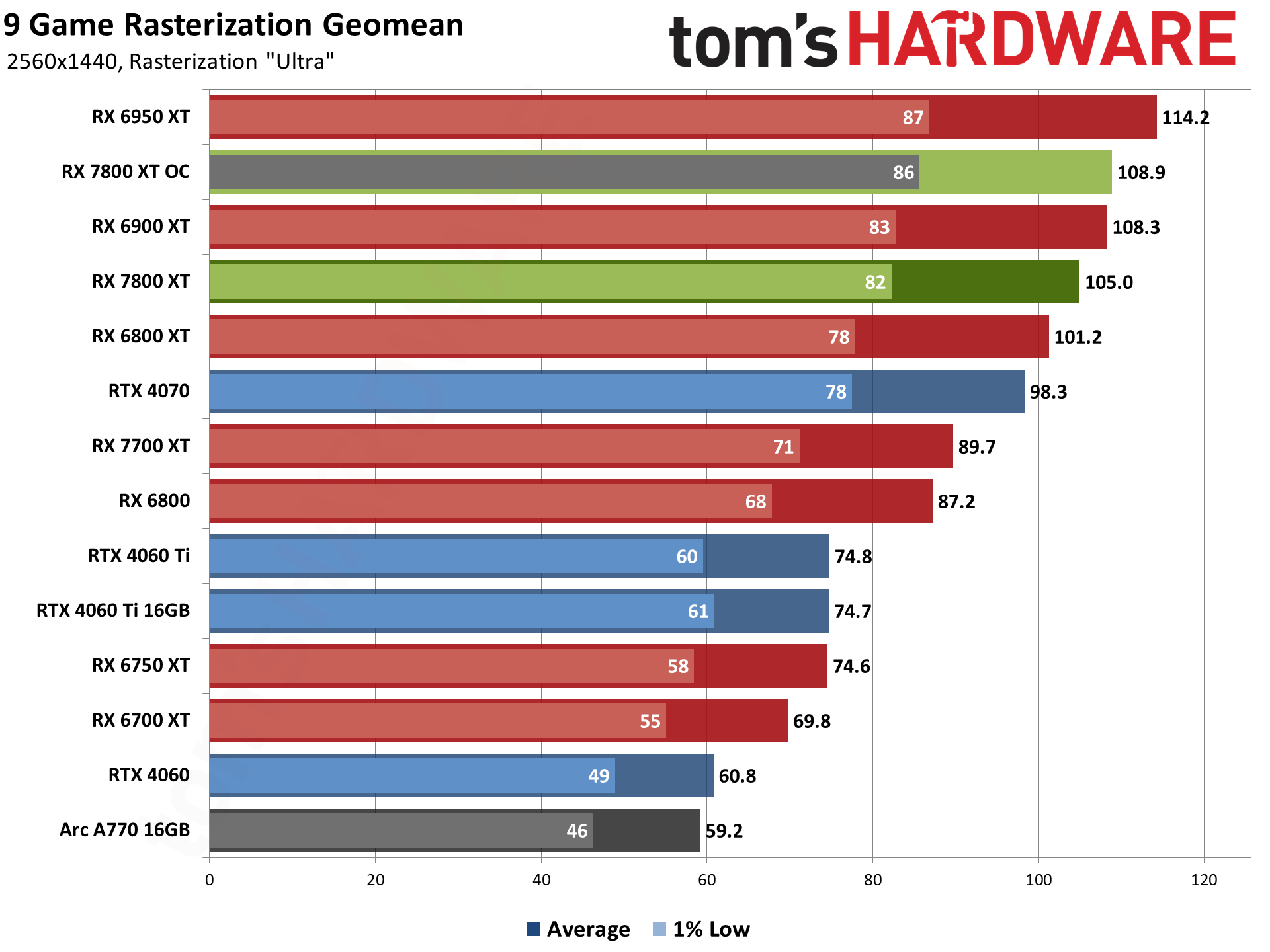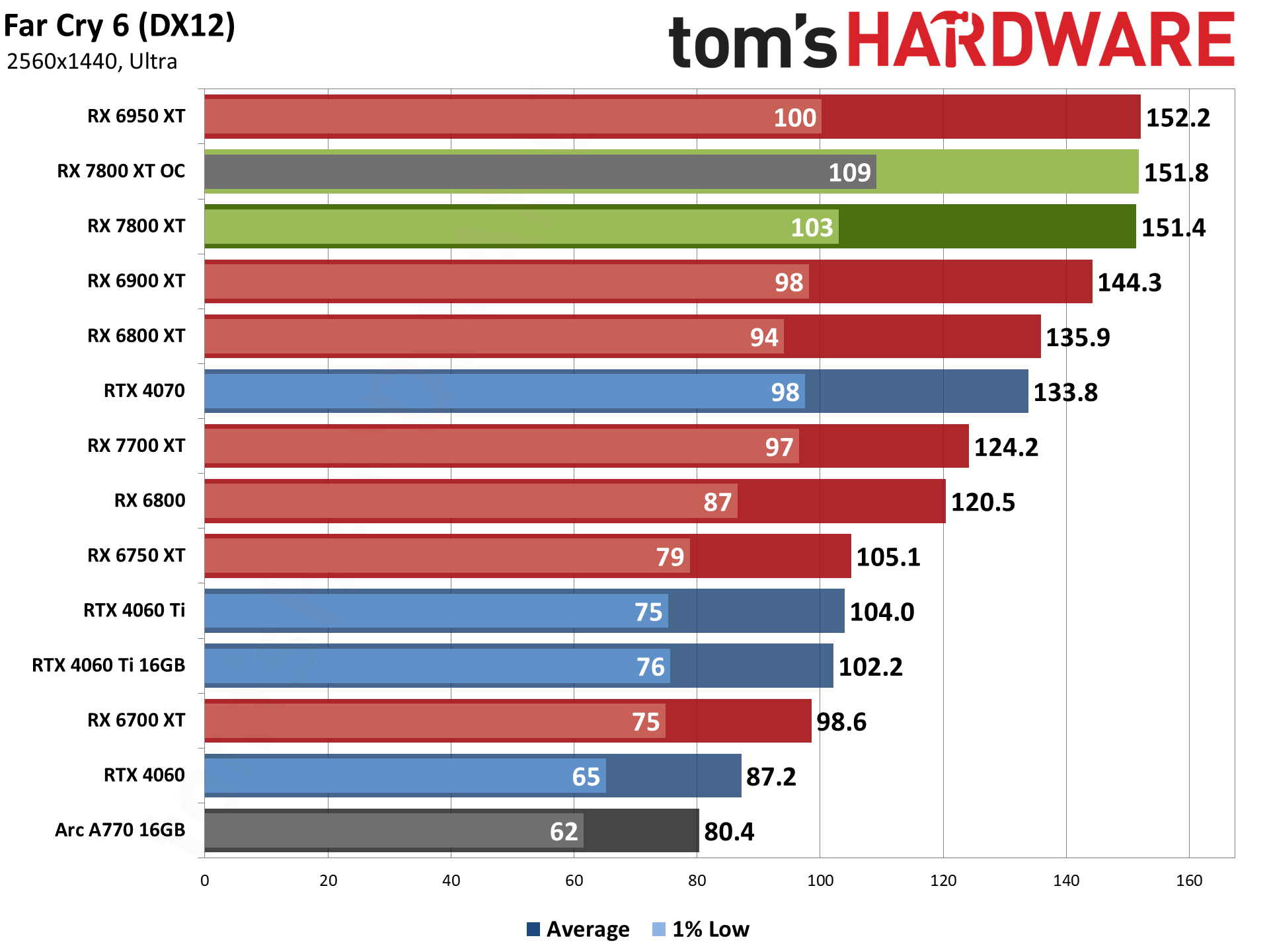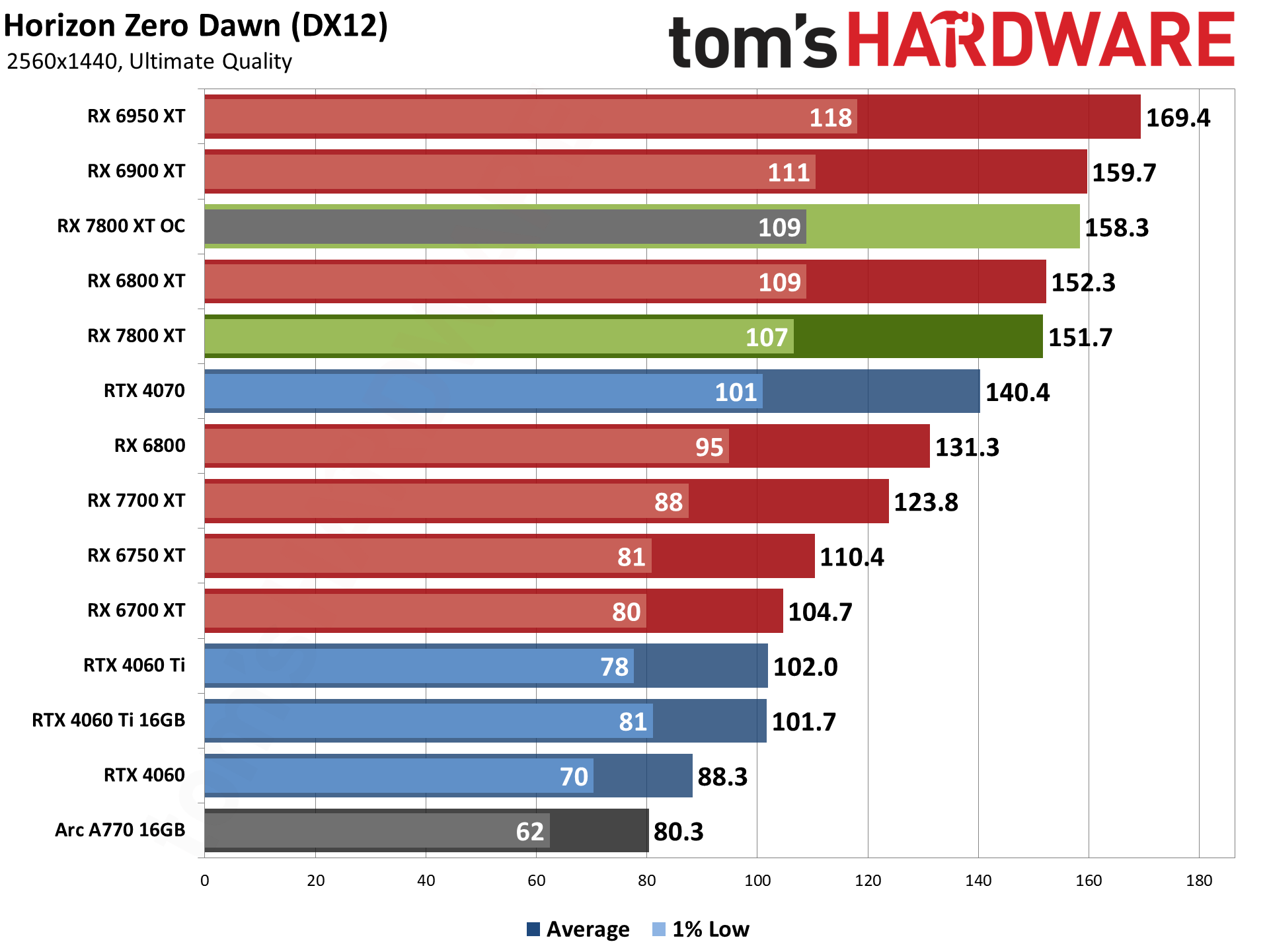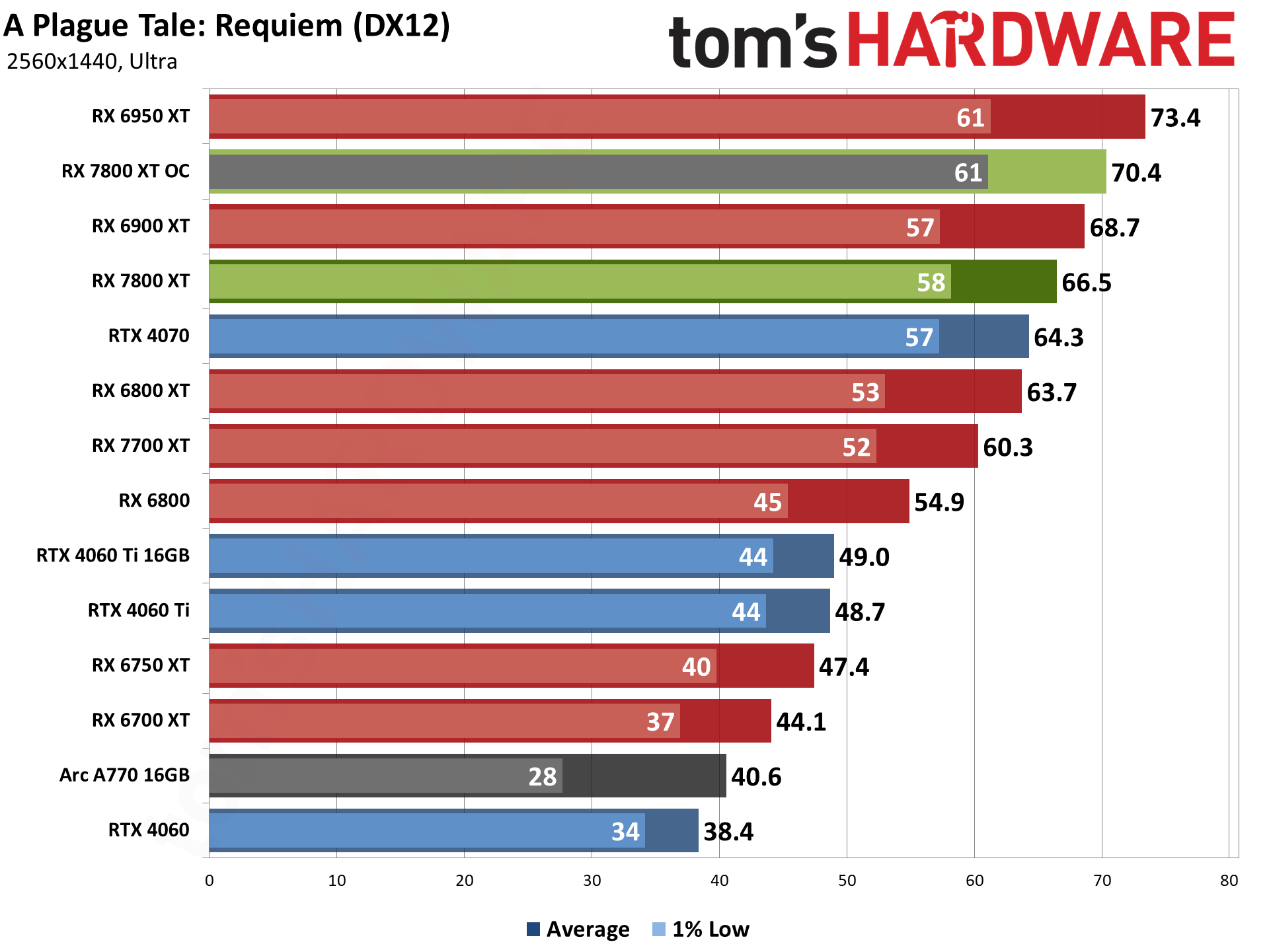Why you can trust Tom's Hardware
According to AMD, the RX 7800 XT primarily targets 1440p gaming. Naturally, that will vary by the complexity of the game, so heavy ray tracing games will likely struggle at native 1440p while lighter games will break into the triple digits. Still, we feel it's a much better estimate of performance than Nvidia's assertion that the RTX 4060 Ti is "made for 1080p" — it's more the 128-bit interface on that GPU that's made for 1080p.
Our current test regimen gives us a global view of performance using the geometric mean of all 15 games in our test suite, including both the ray tracing and rasterization test suites. Then we've got separate charts for the rasterization and ray tracing suites, plus charts for the individual games. If you don't like the "overall performance" chart, the other two are the same view we've previously presented.
Our test suite is intentionally heavier on ray tracing games than what you might normally encounter. That's largely because ray tracing games tend to be the most demanding options, so if a new card can handle ray tracing reasonably well, it should do just fine with less demanding games. Ray tracing also feels increasingly like something we can expect to run well when optimized properly. Mainstream and certainly high-end graphics cards need to be capable of running demanding settings, including ray tracing, at reasonable frame rates.

When AMD announced Navi 32 and the RX 7800 XT, we immediately questioned whether it would even surpass the previous generation RX 6800 XT in performance. Based on AMD's own performance testing, it looked like it would be very close to the RX 6900 XT, which is only 5~8 percent faster than the RX 6800 XT. Our benchmarks put the 7800 XT right between the two, slightly closer to the 6900 XT.
That's not amazing in terms of raw performance, but it's certainly good enough to handle most games at 1440p. You may need to juggle high and ultra settings and decide whether you even want to bother with ray tracing (and/or upscaling). Of course, this level of performance has basically been available from AMD since late 2020, only now the official price is $150 lower — and street prices compared to 2021–2022 are substantially lower. The RX 6800 XT has also been selling for $500~$550 for the past nine months or so, which means AMD's value proposition hasn't changed much.
Against Nvidia's competing GPUs, it shouldn't be surprising that the RX 7800 XT can easily beat the RTX 4060 Ti — it's 26% faster overall. Stepping up to the RTX 4070, it still ends up leading by 6% overall, thanks to the ray tracing advantage, but it's a tight race. As for previous generation Nvidia GPUs (not shown in the charts), the RTX 3080 also comes in 7% faster, while the 7800 XT beats the RTX 3070 Ti by 16%. That means the 7800 XT also beats the original RTX 2080 Ti by about 20% as well.
AMD also offers a lot more VRAM than the competing Nvidia parts, unless you count the 4060 Ti 16GB. Comparing a 256-bit 16GB card with a 128-bit 16GB card shows just how much Nvidia's part gets hamstrung by the limited memory interface and bandwidth. Compute also factors into the equation, of course, but if we're sticking strictly to the $500 or less price point, 1440p gaming is a win for AMD.










Looking at just the nine rasterization games, AMD's GPU moves up a notch in the charts. In pure rasterization, the RX 7800 XT delivers about 7% more performance than the RTX 4070 and 40% more performance than the RTX 4060 Ti — both the 8GB and 16GB variants, as the games in our test suite don't really show an advantage for the extra VRAM at 1440p.
Depending on the games you play, that's a pretty massive gulf in performance between AMD and Nvidia, in favor of Team Red. The 7800 XT ranges between 66 and 152 fps, while the 4060 Ti 8GB range is from 49 to 102 fps. Most rasterization games end up around the ~35% faster mark for AMD, but Total War: Warhammer 3 leans toward the 4060 Ti more and is only 25% faster on the 7800 XT, while Borderlands 3 still heavily favors AMD and offers 59% higher performance. Far Cry 6 and Watch Dogs Legion also favor the 7800 XT more, landing around 50% faster.
Gen-over-gen, the rasterization results show very little difference between the 7800 XT and the 6800 XT. The biggest improvements are in Far Cry 6 and Total War: Warhammer 3, where the new GPU delivers about 10% more performance. Three other games show a 4–5 percent advantage, while the remaining four fall within 1% of each other — a tie for all intents and purposes.







Flipping over to our ray tracing test suite, as usual, the numbers skew in favor of Nvidia's GPUs. Where the 7800 XT was 40% faster across our rasterization suite, in our DXR (DirectX Raytracing) suite, it's only 6% faster. That's still a win for AMD, nominally, but we're also looking at a $400–$450 Nvidia part against a $500 AMD part. However, if we turn to the RTX 4070, Nvidia has a 27% lead in ray tracing performance (compared to a 6% deficit in rasterization performance).
As usual, there's a wide range of results, depending largely on how complex the ray tracing effects happen to be. Cyberpunk 2077 in RT-Ultra mode has the 7800 XT and 4060 Ti tied, while Minecraft puts the 4060 Ti 34% ahead of the 7800 XT. Minecraft implements "full ray tracing," however, and despite the relatively simple graphics (lots of square blocks), all those effects require a lot of RT calculations.
The Bright Memory Infinite benchmark is also very demanding, and AMD squeaks out a minor 8% lead over the 4060 Ti. Control was once the most demanding RT game available, but that was back in 2019, and hardware has improved a lot since then. AMD claims a 16% win there, while Metro Exodus Enhanced increases the lead to 22%, and finally, Spider-Man: Miles Morales gives the 7800 XT a 25% lead over the 4060 Ti.
Stepping up to the 4070 gives Nvidia a clean sweep in the DXR suite, with leads ranging from 9% (Metro) to 81% (Minecraft). One of AMD's claims with RDNA 3 is that ray tracing performance has improved relative to RDNA 2, and that does appear true to some extent. Where the 7800 XT only beat the 6800 XT by 4% on average in our rasterization tests, in DXR, the overall lead grows to 8%. However, we wouldn't read too much into that, as the two most demanding DXR games we tested — Minecraft and Cyberpunk — show a difference of 6% and 7%, respectively.
- MORE: Best Graphics Cards
- MORE: GPU Benchmarks and Hierarchy
- MORE: All Graphics Content
Get Tom's Hardware's best news and in-depth reviews, straight to your inbox.
Current page: Radeon RX 7800 XT: 1440p Ultra Gaming Performance
Prev Page AMD Radeon RX 7800 XT Card and Overclocking Next Page Radeon RX 7800 XT: 1080p Ultra Gaming Performance
Jarred Walton is a senior editor at Tom's Hardware focusing on everything GPU. He has been working as a tech journalist since 2004, writing for AnandTech, Maximum PC, and PC Gamer. From the first S3 Virge '3D decelerators' to today's GPUs, Jarred keeps up with all the latest graphics trends and is the one to ask about game performance.
-
oofdragon IMO its good at $500 since its on par with 6950XT when overclocked. Lets be honest It should have been at least a hair faster than the 6950XT at factory settings but since its $100 cheaper and virtually runs games just the same, its a solid offering. I feel though that at 1440p a card like the 6800XT is plenty enough, now at around $400 on eBay... and while the 7700XT could be a good deal at around that price, we also have the RX6800 with 16GB for $100 less......Reply
My two cents then, anyone into 60fps gaming should just stick with the 6700XT for 1080p and 6800XT for 1440p, why spend more to get the same? At 4K theres the 7900 series for $700/$800 playing any game just the same as the 4090 at half the price, AMD is a no brainer this gen. I went 7900 also for high refresh 1440p and that single game worth playing with RT enabled -
AgentBirdnest From the perspective of a 1440p RTX 2060 owner - who has had my heart set on, and has been saving up for an RTX 4070 for the last few months, I have to say:Reply
I wish I bought a Free-Sync instead of G-Sync monitor (there was no "G-Sync compatible" at the time.) Because the 7800XT is mighty compelling. 4070-like performance for $100 cheaper, and even the ray-tracing performance is close enough that I probably wouldn't notice in most games. A 50-watt difference is actually enough to make me uncomfortable after an hour of gaming in this room. But for $100 less than the 4070, I might be able to live with that.
But I can't live without my variable refresh rate, and am not willing to splurge on a new monitor that I don't need. So, a higher-priced card for me, unless Nvidia drops the price a few bucks or makes a compelling Super-refresh before the end of the year, but I won't hold my breath.
The 7700xt is just... puzzling. All I have to say is, "Why?"
As always, props for the great review, Jarred! I haven't read through every page just yet, I'll do that a bit later. But the benchmarks and analysis I saw so far look great. Thanks for the hard work. -
Elusive Ruse It's a better 6800XT at a lower price, nothing exciting as far as generational leap goes but it beats every card at its price point.Reply -
Frozoken Just so u know u absolutely need to undervolt amd cards when overclocking them to get extra performance. Techpowerup was seeing roughly 15% gains in fps from their ocReply -
Avro Arrow Reply
Sure, but it's SUPPOSED to do that. The cost per frame is SUPPOSED to go down every generation. Remember how the $500 RTX 3070 was slightly faster than the $1200 RTX 2080 Ti? That's what's supposed to happen.Elusive Ruse said:It's a better 6800XT at a lower price, nothing exciting as far as generational leap goes but it beats every card at its price point.
The RX 7800 XT is supposed to be Navi 31, just like the RX 6800 XT is Navi 21. AMD is royally screwing people here with a deceptive naming scheme. -
Colif it competes well against 4070 if you don't use RT, and its cheaper.Reply
It walks all over both 4060 models.
neither AMD or Nvidia have a perfect record this generation when it comes to naming really. -
Elusive Ruse Reply
I don't buy GPUs based on their names. For me it's quite simple; I buy the best bang for my buck regardless of the badge and name.Avro Arrow said:Sure, but it's SUPPOSED to do that. The cost per frame is SUPPOSED to go down every generation. Remember how the $500 RTX 3070 was slightly faster than the $1200 RTX 2080 Ti? That's what's supposed to happen.
The RX 7800 XT is supposed to be Navi 31, just like the RX 6800 XT is Navi 21. AMD is royally screwing people here with a deceptive naming scheme. -
Upacs Reply
Exactly. What matters is price/performance ratio (and features and stability). Naming is irrelevant and only for the clueless consumer that assumes higher is always better. But none of those here, right?Elusive Ruse said:I don't buy GPUs based on their names. For me it's quite simple; I buy the best bang for my buck regardless of the badge and name. -
PEnns I am really tempted to buy the 6800 XT and call it a day (and wait for another 2-3 years maybe).Reply
The 7800 XT seemed like a decent new card - but the deal breaker was the loudness but nothing else really.
